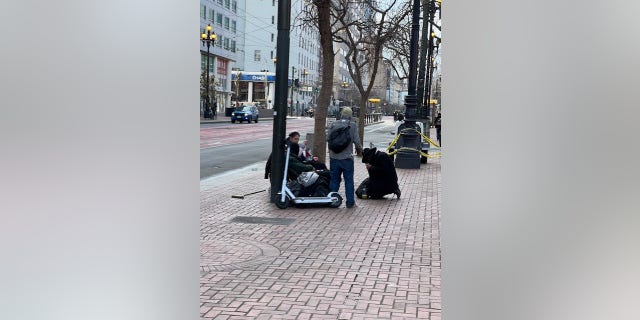San Francisco addiction center ‘resembles an open-air drug market’: Cowan
Fox News senior correspondent Claudia Cowan looks at San Francisco’s taxpayer-funded linkage center’s impact on drug addiction on ‘Special Report.’
San Francisco’s Tenderloin District, notorious for its rampant drug abuse, is home to the city’s new Linkage Center. It’s intended to connect homeless people and drug addicts with basic services, like food and showers, and access to information about how to get sober and off the street.
While some of that may be happening, the scene around the center on Market Street is one of drug dealing, and addicts passed out on the sidewalk. There are multiple accounts of people shooting up or smoking fentanyl inside the Linkage Center as well. (According to a city spokesperson, media are not allowed inside the center for privacy purposes).
San Francisco’s Tenderloin District is known for its rampant drug abuse and homelessness.
This comes less than two months after Mayor London Breed announced an emergency declaration in the Tenderloin, and vowed to crack down on crime and drug use there.
“It’s time that the reign of criminals who are destroying our city to comes to an end,” Breed said at a Dec. 14 news conference. She called for more law enforcement and policies that would be “less tolerant of all the bullsh– that is destroying our city.”
Fueling drug abuse?
But the scene outside the Linkage Center has left some asking whether the services provided to end drug abuse are in fact fueling it. At a news conference last month, Breed was asked why the city was tolerating what appears to be a safe injection site.
‘We have to pick our battles,” and at least give addicts some assistance, she replied.
Homeless people sit in San Francisco’s Tenderloin District
“The goal is to allow people who suffer from addiction to come into this center, no questions asked, to get food, to maybe get a shower, to get support, to get services,” Breed said. “But we’re not forcing anyone to do anything. And at the end of the day, you know, this is a place where there’s no judgment, where there isn’t a one-size-fits-all solution.”
“We’re not forcing anyone to do anything. This is a place where there’s no judgment, where there isn’t a one-size-fits-all solution.”
San Francisco Mayor London Breed speaks outside City Hall, June 1, 2020. (Associated Press)
But advocates for recovery disagree. Tom Wolf was homeless and addicted to heroin and fentanyl, and got clean only after he was arrested and forced into rehab. He’s a staunch critic of the city’s refusal to mandate drug treatment, and says allowing people to use drugs at a site aimed at curbing abuse is like holding an Alcoholics Anonymous meeting at bar.
“How is anybody ever going to get help if they’re allowed to use fentanyl on the site?” he asks.
“How is anybody ever going to get help if they’re allowed to use fentanyl on the site?”
Cornerstones of recovery
Wolf now has nearly 9,000 Twitter followers and gives tours to officials from other cities who want to see just how bad things are. He says holding people responsible for their behavior, and having housing earned as opposed to handed out, are cornerstones of recovery.
A homeless man sits at a San Francisco bus shelter in the Tenderloin District
“We’ve removed all accountability from the process, in the hopes of being more compassionate,” Wolf says. “But what we’re really doing is we’re allowing people to continue to harm themselves and die.”
“We’ve removed all accountability from the process, in the hopes of being more compassionate.”
Now, millions of tax dollars are being spent on a center that resembles an open-air drug market, with no indication that will change anytime soon.
Source: Read Full Article





